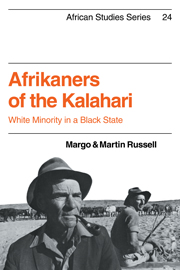Book contents
- Frontmatter
- Contents
- List of illustrations
- Acknowledgements
- A note on terminology
- 1 Southern Africa
- 1 The mundane Kalahari: an introduction
- 2 Boers, trekboers and bywoners: 1898–1930
- 3 Into the cash economy: 1930–72
- 4 Ghanzi Afrikaners 1973: a domestic description
- 5 Preserving boundaries: similarities, ambiguities and avoidances
- 6 Boers and Bushmen: dependence, interdependence and Independence
- 7 Sharing religion: attitudes to the conversion of the Bushmen to Christianity
- 8 Boers, bureaucrats and blacks
- 9 Prospect: whites in a black state
- Notes
- Bibliography
- Index
5 - Preserving boundaries: similarities, ambiguities and avoidances
Published online by Cambridge University Press: 04 August 2010
- Frontmatter
- Contents
- List of illustrations
- Acknowledgements
- A note on terminology
- 1 Southern Africa
- 1 The mundane Kalahari: an introduction
- 2 Boers, trekboers and bywoners: 1898–1930
- 3 Into the cash economy: 1930–72
- 4 Ghanzi Afrikaners 1973: a domestic description
- 5 Preserving boundaries: similarities, ambiguities and avoidances
- 6 Boers and Bushmen: dependence, interdependence and Independence
- 7 Sharing religion: attitudes to the conversion of the Bushmen to Christianity
- 8 Boers, bureaucrats and blacks
- 9 Prospect: whites in a black state
- Notes
- Bibliography
- Index
Summary
It has been suggested that we can find clues to a people's social structure by looking at the paradigms implicit in the classificatory order they impose on the natural world confronting them. A telling image which occurs constantly in Afrikaner accounts is that of a multiplicity of juxtaposed ‘worlds’ each inhabited by an appropriate species. Thus Ghanzi is ‘a lion's world’ and also ‘a cattle world’, but not ‘a sheep's world’ – ‘Down in the south near Nossop, that is a sheep's world.’ South is also ‘a Hottentot's world’, whereas Ghanzi is ‘a Bushmen's world’. Ghanzi is itself a world in contrast to ‘South West’, Ngamiland, or even, laughingly, apologetically, in an unguarded moment, to Botswana itself. ‘Here is Ghanzi's world, there is Botswana.’
Appropriate species can share a world: goats, zebra and eland run with the cattle on the farm veld. Amongst people, a single species with the potential for miscegenation, close juxtaposition of different kinds can be dangerous since social order is seen to rest on the conservation of prevailing identities and boundaries. Thus whites and blacks alike are seen to have a disastrous impact on local Bushmen by disturbing a social order in which the different groups had retained their distinctiveness.
Earlier days the Bushmen were absolutely divided. Here there were the Makoko, in the middle were the Nharo, south were the !Xo, and such. Now they are all mixed up and it's bad.
- Type
- Chapter
- Information
- Afrikaners of the KalahariWhite Minority in a Black State, pp. 58 - 78Publisher: Cambridge University PressPrint publication year: 1979

